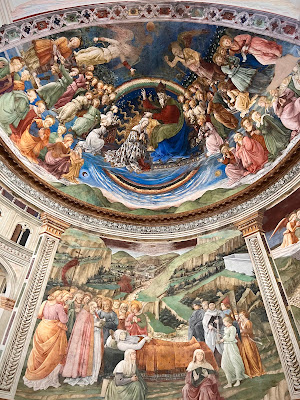Glorious Umbrian Renaissance: Filippo Lippi in Spoleto.
Spoleto is one of the many lovely towns scattered throughout the beautiful Umbrian countryside in central Italy. Tuscany and Umbrian were the breeding ground for some of the greatest artists of the Italian Renaissance. Exploring even the tiniest chapels in the most remote villages can unveil some spectacular masterpieces… so imagine what venturing into a great Medieval cathedral might bring.
The Duomo in Spoleto sits in an imposing part of the city where it dominates its adjacent piazza, the cathedral has some defining Romanesque and Italian Gothic features, under the Baroque arms of the Barberini family of Rome who restored it. Unlike Tuscany, Umbria was part of the papal states. The first thing that comes to mind when looking at the architecture is that the interior might be in the same style and perhaps decorated with some unassuming Medieval frescoes.
If these are your expectations, then prepare to be pleasantly surprised. Upon entering through the church’s gates one is stunned by how bright the nave is, dominating the whole scene, in the apse, is a true vision of heaven. It is a stunning cycle of frescoes on the life of the Blessed Virgin Mary, executed between 1466 and 1469, by Filippo Lippi. He might be better known for being both one of the greatest artists of the Renaissance and also a monk who escaped the monastic life, married a nun, and produced a son who went on to be trained by Botticelli and become a great artist himself: Filippino Lippi.
The frescoes were commissioned around 1466, when Filippo had just completed his other masterpiece in Prato’s Duomo, the stories of the life of the Saints Stephen and John the Baptist. This was his last work and he died while completing this great testament to his genius, prophetically depicting the death of the Mother of Jesus. His death was far less holy, he was apparently poisoned because he kept harassing young women, a cause of great scandal during his Prato sojourn.
Filippo was buried in this cathedral, despite the many insistent requests of his patron, Lorenzo de’Medici, who wanted him in Florence in one of its majestic basilicas, a fit tribute to his genius.
Lippi incorporated the actual architectural elements of the cathedral’s quire in his frescoes. The great arch that divides the nave from the sanctuary opens up on the round apse of the building, making the frescoes a visible centrepiece that captures the viewer’s sight as soon as they would step into the church.
The iconography is traditional, the work is divided into two sections; three panels surrounding the altar and representing the Annunciation, the Death of Mary, and the Nativity of Jesus. Symbolically, right above the death is the Coronation of Mary.
The Annunciation is the first scene that we are to read in this cycle of frescoes. The Archangel Gabriel visits Mary in her own home and brings her the good news of salvation while at the same time, we see God the Father in a cloud of angels, in the upper left, sending the Son into her womb through the Holy Spirit. Mary and the angel are traditionally divided by an architectural element, in this case a Renaissance loggia set in a bucolic setting, remindful of the Umbrian countryside. The delicate features of Mary are distinctive to Filippo Lippi and will recur in the other scenes. It is true Quattrocento stoicism.
Opposite to it is the Nativity, the Incarnation, God is made flesh and dwells with us; the beginning of Christ’s mission here on earth that will conclude with his death on the cross. The scene is set in the ruins of what seems to be a castle or perhaps Bethlehem’s city walls. Up in the heavens, are the angels singing hosannahs to the new born. To the right is the angel calling the shepherds. The iconography of the central scene is quite simple with the basic elements of the Holy Family, and the accidental ox and ass, surrounding God-made-man, simply lying on the rude and bare rock in a much harsher environment to that of the previous scene as a sign of the passion that is to come.
In the center of the lower section is the Dormitio Virginis - this is a recurring theme in the Renaissance, especially in the Quattrocento. This was a time when the theology of the Dormitio and the Assumption of Mary into heaven coexisted, this tradition wasn’t relegated to Eastern theology yet, Rome itself has many examples from the late Middle Ages and Renaissance, notably Cavallini at S. Maria in Trastevere and Pintoricchio at S. Maria del Popolo. This almost is a Dormitio that is turning into an Assumption, Mary is sleeping, she does not seem lifeless, her tomb is distant and empty, the apostles surround her in a procession. It is clear that her mission on earth is over.
This scene leads our eye to the great triumph of the main scene, the Coronation of the Virgin. Within, the mandorla are the Blessed Virgin Mary, wearing a white cope, while being crowned by an enthroned Trinity in the form of God the Father, robbed in full regalia. The scene takes place in the celestial spheres, all shades of blue are present, below the mandorla are the sun and moon in reference to Revelation 12: and a great portent appeared in heaven, a woman clothed with the sun, with the moon under her feet, and on her head a crown of twelve stars… singing the unending hymns of praise to this scene are all the angelic spheres and the saints of the Church triumphant. God’s tabernacle has accomplished her mission and being the good Jewish mom she is, finds a special place by the throne of glory.
Did you know that by visiting the Umbrian countryside you could get to admire a glimpse of heaven?






